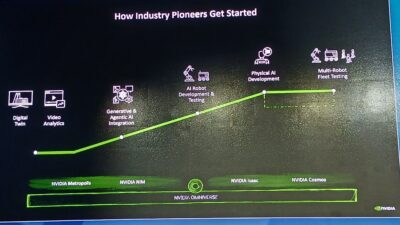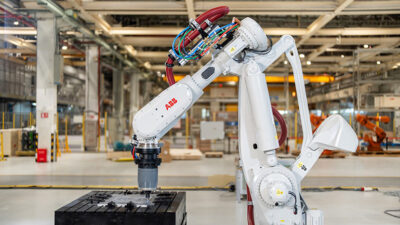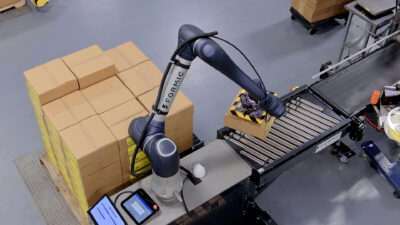The rise of robot technology and the recent introduction of cobots is changing how robotics are utilized in manufacturing.

Robotics insights
- The next stage in the evolution of robotics is mobility and autonomous operation.
- Modular individual transport (MIT) systems and automated guided vehicle (AGV) systems help manufacturers become more flexible and abopens up a new range of opportunities for manufacturing companies.
Over the years, robot technology has improved in many ways – with increased payloads, greater speeds, better accuracy and repeatability, more intuitive and user-friendly programming methods and the ability to interface with other technologies such as vision systems.
The relatively recent introduction of collaborative robots (cobots) has further expanded the range of applications for robots through their ability to operate alongside humans.
The next stage in the evolution of robotics is mobility and autonomous operation. Combining conventional industrial robot and cobot technology with the latest developments in modular individual transport (MIT) systems, and automated guided vehicle (AGV) systems, opens up a new range of opportunities for manufacturing companies to automate and connect component handling, transportation and processing operations throughout a plant.
AGV’s have been around for some time, and although in the early days their functionality and capability was somewhat limited, this technology has also evolved.
Robotics technology advances
Advances in AGV technology, together with the flexibility offered by autonomous mobile robots, is already changing the concept of the production line. The increasing demand for greater levels of flexibility, to manufacture a broader product range or to fulfil demands for product personalisation, has stretched the capacity of traditional fixed manufacturing facilities. The ability to autonomously present the right component parts on demand from the stores or warehouse with the ability to move, relocate or reconfigure different elements of the production line can increase manufacturing flexibility.
In other sectors, perhaps not normally considered to be those which would seek to automate due to the size or nature of their products, the capability of AGV’s and MIT systems is transforming both manufacturing and intralogistics operations. The ability of these technologies to work fully autonomously, combined with their ability to navigate a diverse array of working environments, gather their own materials and then carry out the work, is opening up a wide range of new automation opportunities. The intelligent software used by these systems also makes it possible for AGV’s to seamlessly integrate into Industry 4.0 environments and warehouse management systems.
Just as we have seen the positive impact that industrial robots have brought to manufacturing industries in recent decades, we are now entering the next chapter in industrial automation, where mobility and autonomous operation will become the norm.
– This originally appeared on Control Engineering Europe’s website. Edited by Chris Vavra, web content manager, Control Engineering, CFE Media and Technology, [email protected].



